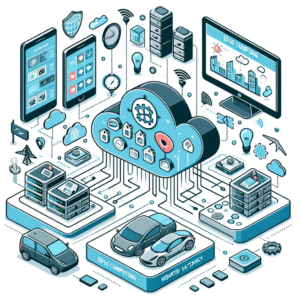In the rapidly evolving landscape of technology, Edge AI stands out as a transformative force, promising to revolutionize how industries operate by enabling real-time data processing. As the demand for faster and more efficient data handling increases, Edge AI emerges as a pivotal solution, offering significant advantages over traditional cloud-based AI systems.
Introduction to Edge AI
Edge AI refers to the deployment of artificial intelligence algorithms and models directly on edge devices—such as smartphones, IoT sensors, and other smart gadgets—close to where data is generated. Unlike traditional cloud-based AI, which relies on centralized servers to process data, Edge AI processes data locally. This shift reduces the reliance on constant internet connectivity and allows for real-time data processing, which is crucial for applications requiring immediate insights and actions.

Technological Advancements Enabling Edge AI
Several technological advancements have paved the way for the rise of Edge AI. The development of powerful microprocessors and specialized AI chips, such as NVIDIA’s Jetson and Google’s Edge TPU, has enabled edge devices to handle complex computations. Additionally, advancements in machine learning algorithms have optimized models to run efficiently on less powerful hardware. These innovations, combined with the proliferation of Internet of Things (IoT) devices, create a robust ecosystem for Edge AI to thrive.
Key Benefits of Edge AI
The adoption of Edge AI offers numerous benefits:
- Reduced Latency: By processing data locally, Edge AI minimizes the delay in data transmission to and from centralized cloud servers, ensuring faster response times crucial for applications like autonomous vehicles and industrial automation.
- Enhanced Data Privacy and Security: Edge AI processes sensitive data locally, reducing the risk of data breaches during transmission and enhancing privacy. This is particularly important in healthcare and finance sectors where data confidentiality is paramount.
- Lower Bandwidth Usage: Local data processing reduces the amount of data transmitted to cloud servers, leading to significant bandwidth savings. This is beneficial in environments with limited connectivity or high data transmission costs.

Real-World Applications of Edge AI
Edge AI is making significant strides across various industries:
- Healthcare: In medical settings, Edge AI enables real-time patient monitoring and diagnostics. Wearable devices equipped with AI can continuously analyze vital signs and alert healthcare providers to any abnormalities, facilitating timely interventions.
- Manufacturing: Edge AI enhances predictive maintenance by analyzing data from machinery in real-time. This allows manufacturers to identify potential issues before they lead to costly downtime, optimizing operational efficiency.
- Retail: Retailers use Edge AI to deliver personalized shopping experiences. By analyzing customer behavior in real-time, stores can offer tailored promotions and recommendations, enhancing customer satisfaction and boosting sales.
- Autonomous Vehicles: Self-driving cars rely on Edge AI for real-time navigation and decision-making. By processing data from sensors and cameras locally, these vehicles can react swiftly to changing road conditions and obstacles.
Challenges and Considerations
Despite its advantages, Edge AI presents several challenges:
- Scalability Issues: Implementing Edge AI across numerous devices can be complex and resource-intensive. Ensuring consistent performance and updates across a dispersed network of edge devices requires robust management systems.
- Integration with Existing Systems: Seamlessly integrating Edge AI with legacy systems can be challenging. Organizations need to carefully plan and execute integration strategies to ensure compatibility and functionality.
- Data Management and Processing Power: Edge devices typically have limited processing power and storage compared to cloud servers. Efficiently managing data and ensuring that AI models run smoothly on these devices is crucial for the success of Edge AI applications.

Future Trends in Edge AI
The future of Edge AI is intertwined with several emerging trends:
- Integration with 5G Technology: The rollout of 5G networks will enhance the capabilities of Edge AI by providing faster and more reliable connectivity. This will enable more sophisticated applications and broader adoption across various sectors.
- Growth in Edge Computing Infrastructure: Investments in edge computing infrastructure will continue to rise, supporting the deployment of more advanced AI applications at the edge. This includes developing more powerful and energy-efficient edge devices.
- Emerging Use Cases and Industries: As Edge AI technology matures, new use cases will emerge, extending its impact to industries such as agriculture, energy, and smart cities. Innovations in these areas will drive further advancements and adoption of Edge AI.
Conclusion
Edge AI is poised to transform industries by enabling real-time data processing and delivering faster, more efficient, and secure AI-driven solutions. As technological advancements continue to push the boundaries of what is possible, Edge AI will play a critical role in shaping the future of various sectors, driving innovation, and enhancing operational efficiency. The journey of Edge AI is just beginning, and its potential to revolutionize industries is vast and promising.


